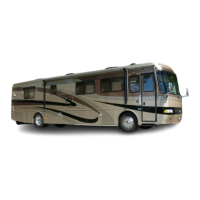The motorhome is a complex vehicle and requires an increased level of
driving awareness and attention because of its size and various components.
Due to the motorhome length the turning radius will be much wider than that
of a standard automobile. Always pay close attention to all perimeters of the
motorhome: front, sides, rear, roof and undercarriage, being sure the surround-
ing area is clear of any obstacles. Utilize the driving mirrors to observe traffic
and parts of the motorhome: tires, bay doors, blind spots, etc. Use a push-pull
method of steering, with both hands parallel on the steering wheel. The
motorhome is also heavier than an automobile, with a higher center of gravity.
These factors affect the reaction time of the motorhome. Swerves and sharp
turns, especially performed at high speeds, could result in the loss of control
of the motorhome. Keep the size of the motorhome in mind and drive with
extra caution to avoid situations which might require quick momentum
changes. Increase your reaction time by paying attention to traffic and road
conditions 12-15 seconds ahead of where the motorhome is at.
The motorhome will travel safely and comfortably at highway speed lim-
its. However, it takes more time to reach highway speed. When passing anoth-
er vehicle allow extra time and space to complete the pass due to the added
length of the motorhome. When descending a long hill, use the exhaust or
engine brake. The transmission and engine will help control downhill speed
and can extend the service life of the brake lining. The distance required to
stop the motorhome is greater than an automobile. The brakes are designed
for the (GVWR) Gross Vehicle Weight Rating. Practice stopping away from
traffic to get the “feel” of the distance required to stop the motorhome.
When backing up, have the co-pilot stand at the driver’s side rear corner so
the co-pilot remains visible in the driver’s rear view mirror. The co-pilot can
watch for any obstacles and give hand signals during the backing up process.
When traveling, make sure bridges being crossed can support the weight of
the motorhome. Check the tonnage limit of the bridges before crossing them.
Signs should be posted at bridge entrances. Check the posted height of any
overpass or situation where overhead clearance is limited. Keep in mind, road
surfaces may have been repaved or become packed with snow and therefore,
the actual posted clearance height would not apply in such conditions.
Driving Cautions:
• Avoid getting too close to the edge of the road, a soft
shoulder may not support the weight of the
motorhome.
• Side spacing is best maintained by keeping the
motorhome centered in the driving lane.
• Driving lanes in work zones can be uneven, congested
and narrower than usual.
• Be cautious of road debris, it can damage the undercar-
riage of the motorhome or become lodged in the dual
tires, causing damage to the tires, wheel rims, or tow car.
Driving & Safety
---------------------------------------------------------------------------------------------------------------------------------------------------------------------------------------------------------------------------------------------------------------------------------------------------------------------
WINDSOR
2•26
Tips for Driving

